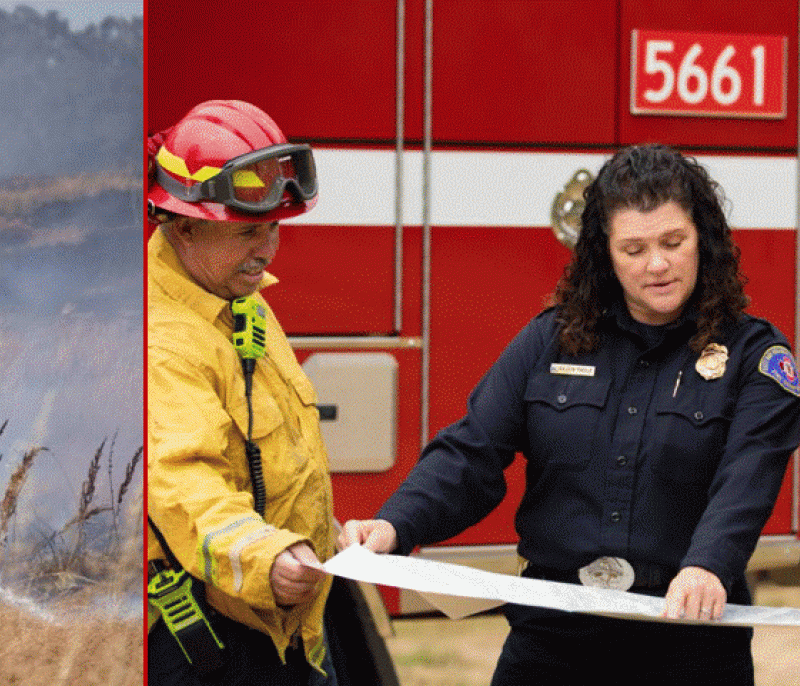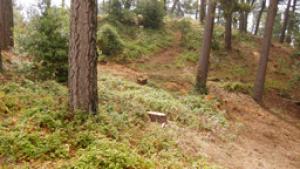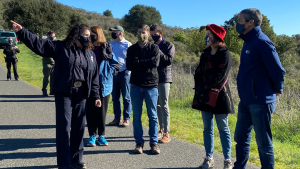What is Fuels Management?
Fuels Management - Act or practice of controlling flammability and reducing resistance to control of wildland fuels through mechanical, chemical, biological, or manual means; or by fire, in support of land management objectives.
Why Fuels Management?
Wildland fire behavior is controlled by three factors: fuels, weather and topography. Because it is impractical to control the weather and topography around us, the only practical way to modify fire is by managing its fuel source. Fire fuel refers to anything that has the ability to burn and spread fire, like trees, shrubs and dried grass.
What are we doing?
- Maintaining a Districts Fuels crew that is a duly trained NWCG (National Wildfire Coordinating Group) Initial Attack Type 2 fire hand crew.
- Clearing heavy underbrush and thinning our dense park forests.
- Reducing vegetation with cattle, goat, and sheep grazing.
- Removing hazardous trees.
- Monitoring effects on habitat and wildlife populations, e.g. nesting birds.
- Partnering with communities, and local and state agencies such as Pacific Gas and Electric Company (PG&E) and East Bay Municipal Utility District (EBMUD), providing mutual aid including use of District helicopter.
Each year the Park District thins and removes hazardous vegetation on over 1,000 acres to reduce fire hazard – much of that thanks to residents in western Alameda and Contra Costa counties who voted in 2004 to support regional park services with additional local funding. The Park District also recently received fire hazard reduction grant funding from FEMA.
See a potential fire hazard in the parks? Report it by calling (510) 881-1833
Fuels Management Practices
EBRPD Fire Department - Vegetation Management Practices - 06m:20s
The East Bay Regional Park Fire Department uses several different methods to modify or reduce the amount or availability of wildland fuels for any fire that may occur. Ladder and surface fuels such as grass, brush, forest litter, and down logs and branches are modified or removed by hand crews, prescribed fire, mowing, weed-eating, masticating, or animal grazing. Dense tree stands are often thinned to remove some of the trees that typically contributes to fuel loading and to reduce the potential for wildfire to spread in the tree canopies.
Introduction to Wildland Fuel Management by World of Wildland Fire - 12m:00s
For more information about different Fuels Management treatments see Fuels Management Techniques [PDF]
Fuels Management Planning
The EBRPD Fire Department follows the Wildfire Hazard Reduction and Resource Management Plan as a guiding tool for what fuel management approaches should be used throughout the East Bay Parks. The plan is consulted for strategies to implement the various types of fuels management processes. Because the execution of any project will affect the surrounding environment, the associated Environmental Impact Report (EIR) informs concerned parties about the anticipated effects of implementing the plan.
You can find both resources on the East Bay Hills Wildfire Hazard Reduction And Resource Management Plan and Environmental Impact Report.
In compliance with the Plan and Environmental Impact Report, the District Fire Department creates an annual work plan of fuels treatment projects. The success of the projects depends largely on the collaborative work that is done with Park Stewardship, Park Operations, park supervisors, and other departments.
Fuels Crew
The district maintains a duly trained National Wildfire Coordinating Group Initial Attack Type 2 fire hand crew. The crew operates under two Fuels Crew Leaders and a Fire Captain. The crew focuses on reducing available material that can act as fuel for wildland fires. This important work reduces the likelihood and potential scale of wildland fires in our parks. Members of the crew are also trained in emergency first aid for safety personnel according to California title 22 regulations.
If you are interested in any Fire department positions, visit Human Resources/Jobs and check for job availability or fill out a job interest card to stay notified about openings. You can fill out a job interest card for any position in the Fire Department by clicking "Subscribe" under any of the job descriptions at East Bay Regional Park District (governmentjobs.com).
Tree Dieback in the Parks

In 2020, Park District staff began to notice signs of decline and leaf loss in trees across a broad swath of East Bay parklands, most notably in the East Bay hills and northern shoreline parks. The principal species affected are eucalyptus species, Monterey pine, acacia, and some native trees and shrubs to a lesser extent. As of 2021, 1500 acres of sudden tree mortality has occurred on District lands. The likely cause is related to the several recent severe droughts with potential secondary cause of fungal infection and insect damage.
The East Bay Regional Parks Fire and Stewardship Departments are collaborating with other agencies and with CalFire to address a response to the dieback and die-offs. EBRPD continues to monitor the situation and is working to direct resources to mitigate the potential for increased fire risk as a result of the increase in dry and dead fuels. Staff has mapped the extent of the dieback areas and will continue to update this mapping as the effect of summer drought continues.
Download: Mapped Dieback Areas [PDF]
Resources
Annual Maintenance
Following initial treatment, long term and continued maintenance is performed to ensure the identified treatment area will continue to be effective. Maintenance activities are scheduled based on ongoing inventories and assessments conducted by Fire Department Fuels Management staff. The most appropriate techniques and methods are chosen and implemented at the most appropriate time to have the greatest efficacy and resultant reduction in fire hazard.
Maintenance activities are performed throughout the year by the Park District’s Fire Department, contractors and adjacent agencies.
The fuels management objectives for a treatment area determines the technique and timing of maintenance work to reduce fire activity, rate of spread, and ember production. Weed whacking, mowing, grazing, and prescribed fire are techniques used to reduce accumulated regrowth of fine fuels while thinning and pruning with chainsaws, brush mastication, chipping, and prescribed fire are used to reduce accumulated medium and heavy fuels and also decrease the vertical continuity and break up the horizontal arrangement.
Goat Grazing Activities
Visitors to the East Bay Regional Parks may encounter cattle, sheep or goats grazing on the grasslands. The District uses grazing animals as a practical and economic resource management tool. Grazing helps reduce fire hazards by controlling the amount and distribution of grasses and other potential fuel. Around urban settings, goats are often used in conjunction with human work crews and prescribed burns to create fuel breaks –a proactive effort to manage future wildfires.
The goat grazing calendar is only an estimate. Park operations, weather, fuel height, and innumerable variables can impact the completion dates. We schedule in target dates to help manage the contract. We review each site for completion on the target date. Contractors receives payment for each site completed.
Download: Goat Grazing Schedule (PDF)
Download: Grazing Brochure (PDF)
How You Can Help
To find out more about how you can help prevent and reduce the effect of wildland fires.


